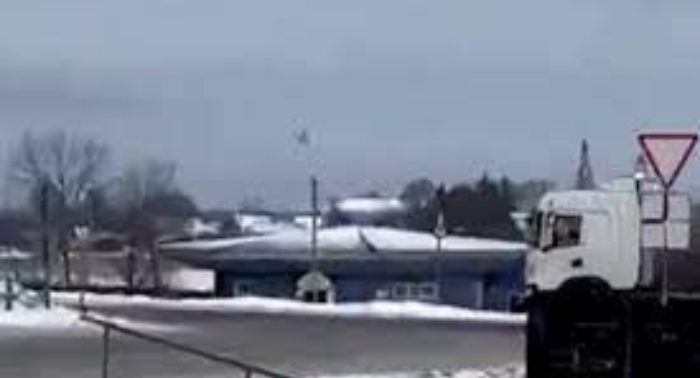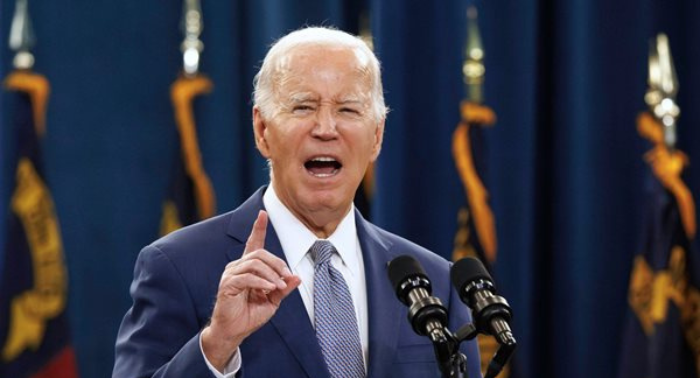Russia’s Defense Ministry has accused Ukrainian forces of shooting down a military transport plane, resulting in the tragic loss of all 74 individuals on board, including 65 Ukrainian prisoners of war (POWs) who were en route for a planned prisoner exchange in Russia’s Belgorod region.
Ukrainian officials have not yet commented on the incident, and The Associated Press has been unable to confirm the identities of those aboard. Authorities in Kyiv have urged caution in disseminating unverified information.
The ill-fated Il-76 transport aircraft carried 65 POWs, a crew of six, and three additional passengers, according to the Russian Defense Ministry. Russian radar reportedly detected the launch of two Ukrainian missiles from Ukraine’s Kharkiv region, bordering Belgorod, leading the ministry to classify the attack as a “terrorist act.”
Video footage of the incident, shared on social media, depicts the plane plummeting from the sky in a snow-covered rural area, followed by a massive explosion upon impact.
Emergency responders, including firefighters, ambulances, and police, quickly converged on the crash site in the Korochansky district of Belgorod, as reported by the state news agency Tass.
The Russian Defense Ministry had been coordinating the transportation of the POWs to the Belgorod region for a scheduled prisoner exchange.
Belgorod Governor Vyacheslav Gladkov refrained from specifying the identities of the plane’s occupants. However, two senior Russian lawmakers, without providing concrete evidence, suggested that the aircraft was brought down by Ukrainian-launched missiles.
Russia has largely maintained air superiority throughout the ongoing conflict, which has now entered its 700th day. Despite this, the Russian air force has experienced a series of accidents, with some attributing them to increased flight activity amid the Ukraine conflict. Conversely, Kyiv has claimed to have successfully downed two Russian command and control planes, potentially a significant achievement for Ukraine if verified. In recent months, cross-border attacks on Russia’s Belgorod region have escalated, with one such attack in late December claiming the lives of 21 people.
Shortly before the plane crash, Governor Gladkov issued a “missile alert” for the region, advising residents to seek shelter.
Ukraine’s Coordination Headquarters for the Treatment of Prisoners of War has acknowledged the crash but has not yet provided details. The organization urged caution when sharing unverified information and highlighted that hostile entities were actively conducting disinformation campaigns to destabilize Ukrainian society.
The Russian Defense Ministry announced the dispatch of a specialized military commission to the crash site to conduct a thorough investigation. In addition to the POWs, the Il-76 cargo plane was transporting three accompanying individuals and a crew of six.
Dmitry Peskov, spokesperson for Russian President Vladimir Putin, refrained from offering comment on the incident due to the limited available information.
The Il-76 aircraft is designed to carry up to 225 troops, cargo, military equipment, and weapons, as specified by Russia’s military export agency.
As the conflict’s front line has remained relatively static over a 1,500-kilometer front, both sides have focused on replenishing their weapons supplies. Recent developments have emphasized long-range strikes.
Ukrainian President Volodymyr Zelenskyy revealed that a major Russian missile attack on Tuesday had resulted in 18 fatalities and 130 injuries. The barrage involved over 40 ballistic, cruise, anti-aircraft, and guided missiles, targeting 130 residential buildings in three Ukrainian cities. Zelenskyy characterized these structures as “ordinary houses.” The attack included locations in the capital, Kyiv, and the second-largest city, Kharkiv, making it one of the most intense in recent weeks. Zelenskyy appealed for increased Western military aid, particularly in bolstering air defenses.
Analysts have speculated that Russia amassed a significant missile stockpile, intending to conduct aerial bombardments during the winter months, while Ukraine has explored using new drone technologies for strikes inside Russia.
In the wake of the missile attack, it is suggested that Russia may have employed decoy missiles to probe weaknesses in Ukraine’s air defenses, as proposed by a U.S. think tank, the Institute for the Study of War. The think tank also highlighted Russia’s pursuit of additional ballistic missiles from foreign sources, including Iran and North Korea, which might offer greater effectiveness in certain scenarios.
Another round of Russian S-300 missile strikes struck residential areas in Kharkiv late on Tuesday, injuring nine people and causing damage to residential buildings, according to regional Governor Oleh Syniehubov. Russia has consistently denied targeting civilian areas, despite substantial evidence to the contrary.
Additionally, the Russian Defense Ministry reported that Russian air defenses successfully downed four Ukrainian drones over western Russia’s Oryol region early on Wednesday. Oryol Mayor Yuri Parakhin noted that several drones were intercepted over the city, causing no casualties but shattering windows in apartment buildings. Another Ukrainian drone was downed over the Belgorod border region, as reported by Governor Gladkov, resulting in no casualties or damage.
While Ukraine’s allies have pledged to continue supplying military aid packages, they face resource constraints. The United States, the largest contributor to Ukraine’s military support, has faced political hurdles in its efforts to provide assistance.
In separate developments, the German Defense Ministry has announced plans to send six Sea King Mk41 helicopters to Ukraine.




